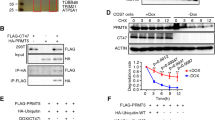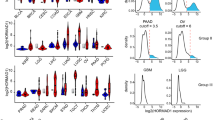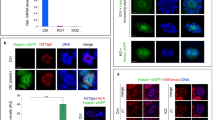Abstract
Cytogenetic analysis has identified 12p gain as the most frequent abnormality in human testicular germ cell tumors (TGCTs). It has been suggested that amplification and overexpression of stem cell-associated genes, including cyclin-D2, on the human chromosome 12p region are involved in germ cell tumorigenesis. By subtractive cDNA analysis, we identified Ddx1, a member of the DEAD-box protein family, as a gene predominantly expressed in the primordial germ cells of mouse embryos. Knockdown of Ddx1 in a mouse spermatogonia-derived cell line, GC-1spg, by short interference RNA repressed the expression of cyclin-D2, CD9 and GDF3 genes. In the mouse cyclin-D2 gene, a genomic DNA region between −348 and −329 was responsible for transcriptional activation by DDX1 based on reporter and gel shift assays. Similarly, DDX1 knockdown in the human TGCT cell line NEC8 repressed the expression of stem cell-associated genes localized on chromosome 12p13.3, including cyclin-D2, CD9 and NANOG. DDX1-knocked-down TGCT cells could not form solid tumors in nude mice. Furthermore, in situ hybridization revealed that DDX1 mRNA was produced in both seminoma and nonseminoma types of human TGCT samples. We conclude that DDX1 is a critical factor for testicular tumorigenesis.
This is a preview of subscription content, access via your institution
Access options
Subscribe to this journal
Receive 50 print issues and online access
$259.00 per year
only $5.18 per issue
Buy this article
- Purchase on Springer Link
- Instant access to full article PDF
Prices may be subject to local taxes which are calculated during checkout






Similar content being viewed by others
References
Atkin NB, Baker MC . (1982). Specific chromosome change, i(12p), in testicular tumours? Lancet 2: 1349.
Beumer TL, Roepers-Gajadien HL, Gademan IS, Kal HB, de Rooij DG . (2000). Involvement of the D-type cyclins in germ cell proliferation and differentiation in the mouse. Biol Reprod 63: 1893–1898.
Biermann K, Heukamp LC, Steger K, Zhou H, Franke FE, Sonnack V et al. (2007). Genome-wide expression profiling reveals new insights into pathogenesis and progression of testicular germ cell tumors. Cancer Genomics Proteomics 4: 359–367.
Bosl GJ, Motzer RJ . (1997). Testicular germ-cell cancer. N Engl J Med 337: 242–253.
Chaganti RS, Houldsworth J . (1998). The cytogenetic theory of the pathogenesis of human adult male germ cell tumors. Review article. APMIS 106: 80–83; discussion 83–84.
Chaganti RS, Houldsworth J . (2000). Genetics and biology of adult human male germ cell tumors. Cancer Res 60: 1475–1482.
de Rooij DG . (1998). Stem cells in the testis. Int J Exp Pathol 79: 67–80.
de Valoir T, Tucker MA, Belikoff EJ, Camp LA, Bolduc C, Beckingham K . (1991). A second maternally expressed Drosophila gene encodes a putative RNA helicase of the ‘DEAD box’ family. Proc Natl Acad Sci USA 88: 2113–2117.
Fujino R, Tanaka K, Morimatsu M, Tamura K, Kogo H, Hara T . (2006). Spermatogonial cell-mediated activation of an IkappaBzeta-independent nuclear factor-kappaB pathway in Sertoli cells induces transcription of the lipocalin-2 gene. Mol Endocrinol 20: 904–915.
Godbout R, Packer M, Bie W . (1998). Overexpression of a DEAD box protein (DDX1) in neuroblastoma and retinoblastoma cell lines. J Biol Chem 273: 21161–21168.
Godbout R, Squire J . (1993). Amplification of a DEAD box protein gene in retinoblastoma cell lines. Proc Natl Acad Sci USA 90: 7578–7582.
Hori H, Yano S, Koufuji K, Takeda J, Shirouzu K . (2004). CD9 expression in gastric cancer and its significance. J Surg Res 117: 208–215.
Houldsworth J, Reuter V, Bosl GJ, Chaganti RS . (1997). Aberrant expression of cyclin D2 is an early event in human male germ cell tumorigenesis. Cell Growth Differ 8: 293–299.
Hubank M, Schatz DG . (1994). Identifying differences in mRNA expression by representational difference analysis of cDNA. Nucleic Acids Res 22: 5640–5648.
Javed A, Barnes GL, Jasanya BO, Stein JL, Gerstenfeld L, Lian JB et al. (2001). runt homology domain transcription factors (Runx, Cbfa, and AML) mediate repression of the bone sialoprotein promoter: evidence for promoter context-dependent activity of Cbfa proteins. Mol Cell Biol 21: 2891–2905.
Kanatsu-Shinohara M, Toyokuni S, Shinohara T . (2004). CD9 is a surface marker on mouse and rat male germline stem cells. Biol Reprod 70: 70–75.
Kawashima M, Doh-ura K, Mekada E, Fukui M, Iwaki T . (2002). CD9 expression in solid non-neuroepithelial tumors and infiltrative astrocytic tumors. J Histochem Cytochem 50: 1195–1203.
Korkola JE, Houldsworth J, Chadalavada RS, Olshen AB, Dobrzynski D, Reuter VE et al. (2006). Down-regulation of stem cell genes, including those in a 200-kb gene cluster at 12p13.31, is associated with in vivo differentiation of human male germ cell tumors. Cancer Res 66: 820–827.
Kubota H, Avarbock MR, Brinster RL . (2003). Spermatogonial stem cells share some, but not all, phenotypic and functional characteristics with other stem cells. Proc Natl Acad Sci USA 100: 6487–6492.
Kubota H, Avarbock MR, Brinster RL . (2004). Culture conditions and single growth factors affect fate determination of mouse spermatogonial stem cells. Biol Reprod 71: 722–731.
Linder P . (2006). Dead-box proteins: a family affair—active and passive players in RNP-remodeling. Nucleic Acids Res 34: 4168–4180.
Linder P, Lasko PF, Ashburner M, Leroy P, Nielsen PJ, Nishi K et al. (1989). Birth of the D-E-A-D box. Nature 337: 121–122.
Morita S, Kojima T, Kitamura T . (2000). Plat-E: an efficient and stable system for transient packaging of retroviruses. Gene Therapy 7: 1063–1066.
Motoyama T, Watanabe H, Yamamoto T, Sekiguchi M . (1987). Human testicular germ cell tumors in vitro and in athymic nude mice. Acta Pathol Jpn 37: 431–448.
Nakayama H, Nishiyama H, Higuchi T, Kaneko Y, Fukumoto M, Fujita J . (1996). Change of cyclin D2 mRNA expression during murine testis development detected by fragmented cDNA subtraction method. Dev Growth Differ 38: 141–151.
Rocak S, Linder P . (2004). DEAD-box proteins: the driving forces behind RNA metabolism. Nat Rev Mol Cell Biol 5: 232–241.
Rodriguez E, Mathew S, Mukherjee AB, Reuter VE, Bosl GJ, Chaganti RS . (1992). Analysis of chromosome 12 aneuploidy in interphase cells from human male germ cell tumors by fluorescence in situ hybridization. Genes Chromosomes Cancer 5: 21–29.
Rosenberg C, Van Gurp RJ, Geelen E, Oosterhuis JW, Looijenga LH . (2000). Overrepresentation of the short arm of chromosome 12 is related to invasive growth of human testicular seminomas and nonseminomas. Oncogene 19: 5858–5862.
Shuin T, Misaki H, Kubota Y, Yao M, Hosaka M . (1994). Differential expression of protooncogenes in human germ cell tumors of the testis. Cancer 73: 1721–1727.
Sicinski P, Donaher JL, Geng Y, Parker SB, Gardner H, Park MY et al. (1996). Cyclin D2 is an FSH-responsive gene involved in gonadal cell proliferation and oncogenesis. Nature 384: 470–474.
Sperger JM, Chen X, Draper JS, Antosiewicz JE, Chon CH, Jones SB et al. (2003). Gene expression patterns in human embryonic stem cells and human pluripotent germ cell tumors. Proc Natl Acad Sci USA 100: 13350–13355.
Squire JA, Thorner PS, Weitzman S, Maggi JD, Dirks P, Doyle J et al. (1995). Co-amplification of MYCN and a DEAD box gene (DDX1) in primary neuroblastoma. Oncogene 10: 1417–1422.
Summersgill B, Osin P, Lu YJ, Huddart R, Shipley J . (2001). Chromosomal imbalances associated with carcinoma in situ and associated testicular germ cell tumours of adolescents and adults. Br J Cancer 85: 213–220.
Sunden Y, Semba S, Suzuki T, Okada Y, Orba Y, Nagashima K et al. (2007). DDX1 promotes proliferation of the JC virus through transactivation of its promoter. Microbiol Immunol 51: 339–347.
Tanaka K, Tamura H, Tanaka H, Katoh M, Futamata Y, Seki N et al. (2002). Spermatogonia-dependent expression of testicular genes in mice. Dev Biol 246: 466–479.
Watsuji T, Okamoto Y, Emi N, Katsuoka Y, Hagiwara M . (1997). Controlled gene expression with a reverse tetracycline-regulated retroviral vector (RTRV) system. Biochem Biophys Res Commun 234: 769–773.
Weber A, Imisch P, Bergmann E, Christiansen H . (2004). Coamplification of DDX1 correlates with an improved survival probability in children with MYCN-amplified human neuroblastoma. J Clin Oncol 22: 2681–2690.
Acknowledgements
We thank Y Futamata (Nippon Becton Dickinson) for help in the cell sorting experiments. We extend our thanks to all laboratory members for their technical assistance and valuable advice. The anti-SSEA-1 antibody (MC-480) developed by Dr D Solter and Dr BB Knowles was obtained from the Developmental Studies Hybridoma Bank developed under the auspices of the NICHD and was maintained by the University of Iowa, Department of Biological Sciences, Iowa City, IA 52242. This work was supported by Grants-in-Aid for Scientific Research from the Ministry of Education, Culture, Sports, Science, and Technology of Japan.
Author information
Authors and Affiliations
Corresponding authors
Additional information
Supplementary Information accompanies the paper on the Oncogene website (http://www.nature.com/onc)
Supplementary information
Rights and permissions
About this article
Cite this article
Tanaka, K., Okamoto, S., Ishikawa, Y. et al. DDX1 is required for testicular tumorigenesis, partially through the transcriptional activation of 12p stem cell genes. Oncogene 28, 2142–2151 (2009). https://doi.org/10.1038/onc.2009.89
Received:
Revised:
Accepted:
Published:
Issue Date:
DOI: https://doi.org/10.1038/onc.2009.89
Keywords
This article is cited by
-
Overexpression of DDX49 in prostate cancer is associated with poor prognosis
BMC Urology (2023)
-
DDX1 is a prognostic biomarker and correlates with immune infiltrations in hepatocellular carcinoma
BMC Immunology (2022)
-
The DEAD-box protein family of RNA helicases: sentinels for a myriad of cellular functions with emerging roles in tumorigenesis
International Journal of Clinical Oncology (2021)
-
MYC-associated protein X binding with the variant rs72780850 in RNA helicase DEAD box 1 for susceptibility to neuroblastoma
Science China Life Sciences (2021)
-
DEAD-box helicase 27 promotes colorectal cancer growth and metastasis and predicts poor survival in CRC patients
Oncogene (2018)



